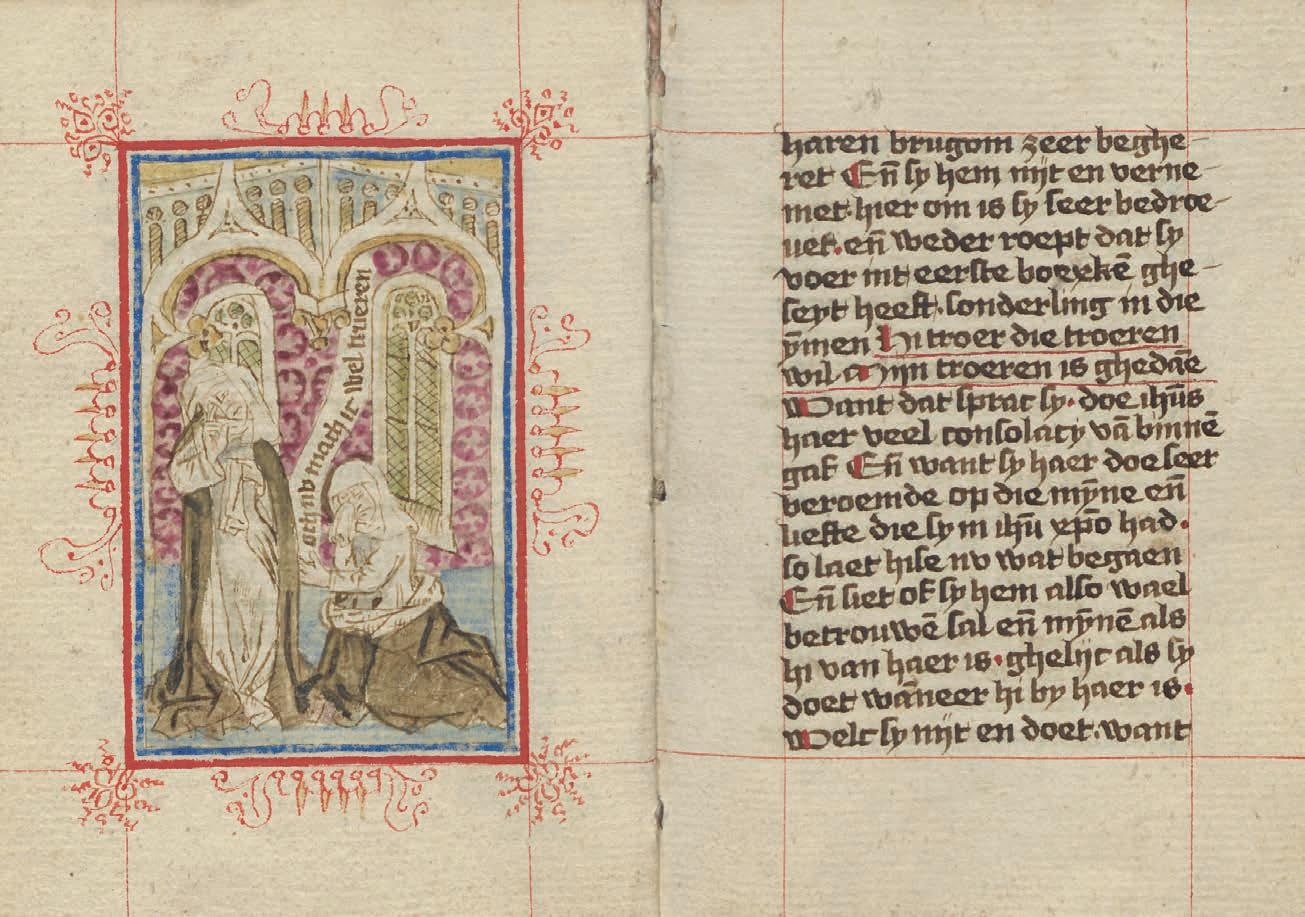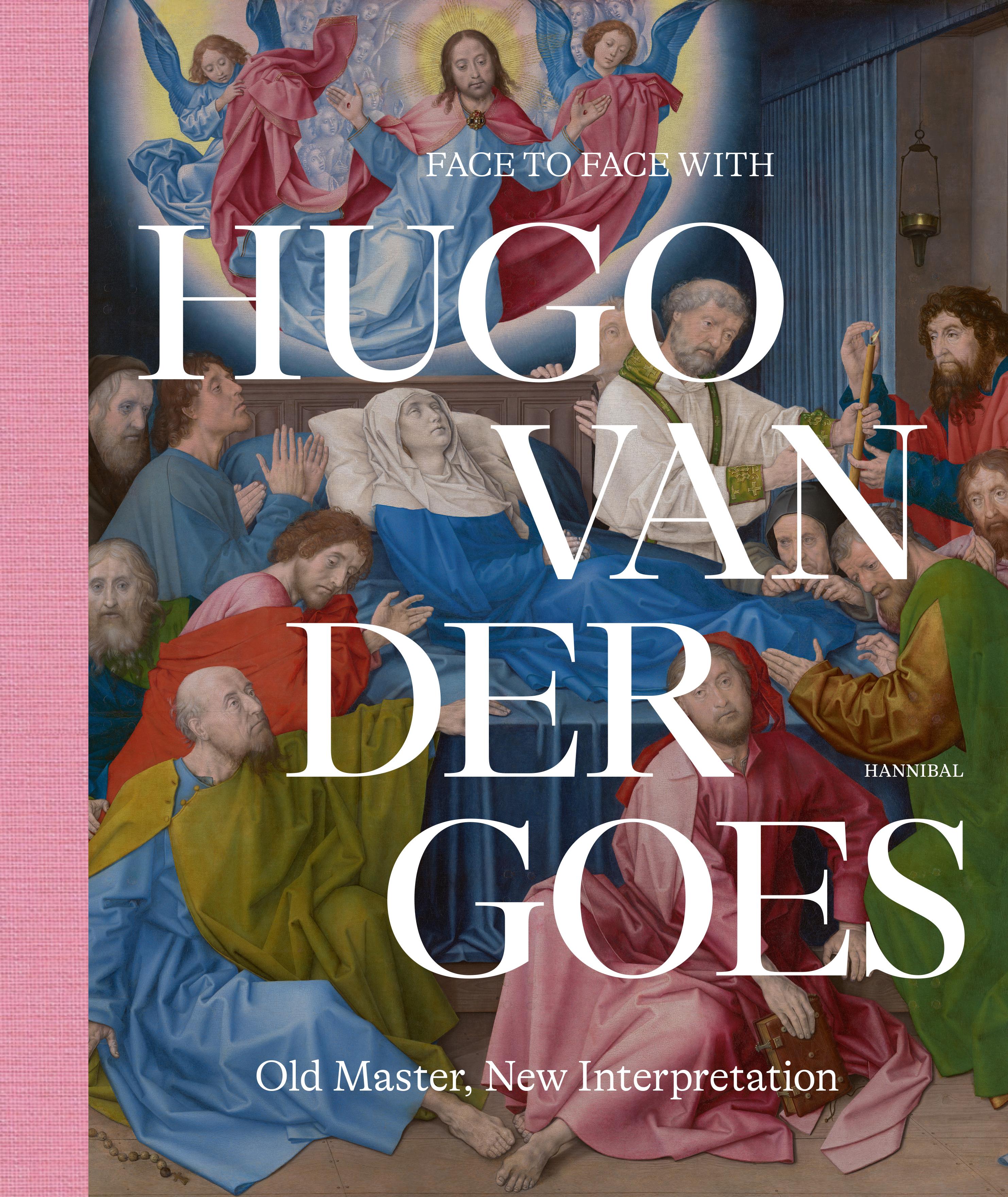
FACE TO FACE WITH HUGO VAN DER GOES
Matthias Depoorter
Lieven De Visch
Marijn Everaarts
Sibylla Goegebuer
Griet Steyaert
Anne van Oosterwijk
FACE TO FACE WITH
Old Master, New Interpretation
HANNIBALCONTENTS
6 FOREWORD
Anne van Oosterwijk 13 Hugo van der Goes and The Death of the Virgin Matthias Depoorter 55 Hugo van der Goes, Life and Work Marijn Everaarts 85 The Restoration of The Death of the Virgin Griet Steyaert 101 The Death of the Virgin, a Powerful Story
Lieven De Visch, Marijn Everaarts, Sibylla Goegebuer & Anne van Oosterwijk 139 BIBLIOGRAPHY
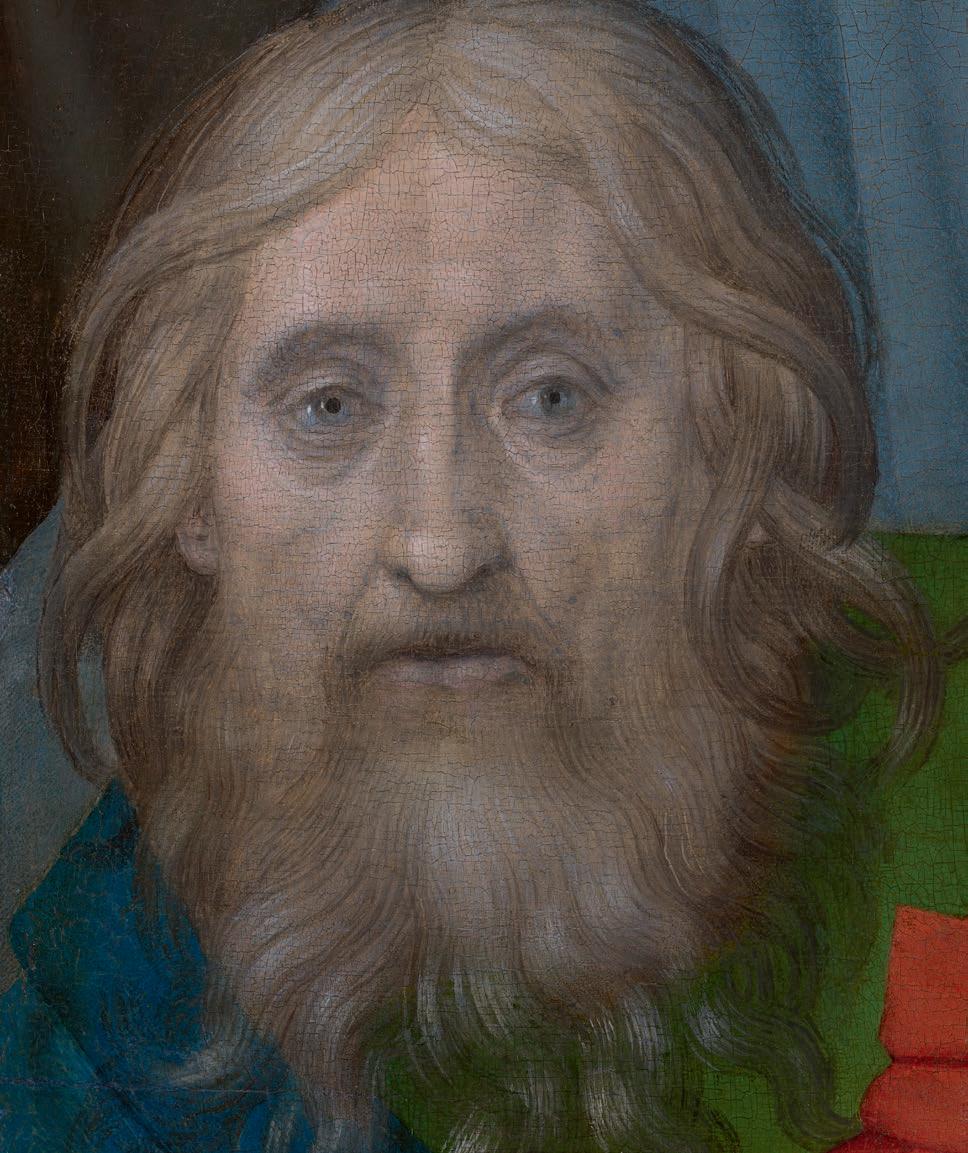
FOREWORD
Anne
van Oosterwijk, Director of Collection Musea BruggeIn 2017, at the initiative of former director Till-Holger Borchert, Musea Brugge launched an ambitious restoration project. The Death of the Virgin by Hugo van der Goes had already been high on the restoration wish list for some time, but the fragile state of the work had acted as a brake on any efforts in that sense. After an extensive preliminary study, however, Griet Steyaert began the restoration process under the supervision of an international advisory committee. A generous subsidy from the Flemish Masterpieces Committee set the project in motion. A long, intensive and complex process, it was above all an enriching one. Hugo’s work had always been among the favourites of both the museum staff and the public, but this restoration behind closed doors only heightened admiration for the work and the artist.
It was therefore only natural for Musea Brugge to organise an exhibition in which the work – after its long absence from the galleries – would take centre stage: Face to Face with Death. Hugo van der Goes, Old Masters and New Interpretations (28 October 2022–5 February 2023). The power of the painting, which is even more apparent now that the restoration is complete, convinced Elviera Velghe, Director of Public Affairs & Exhibitions, and Anne van Oosterwijk, Director of Collection, that an exhibition built entirely around this one work would be most interesting. After all, a masterpiece of this calibre deserves a great deal of attention. Perhaps contrary to expectations, however, this is not an exhibition focused on a single work. The exhibition features some seventy objects, and almost all these works of art and heritage objects date from Hugo’s time. They support, explain and contextualise the various themes present in The Death of the Virgin. They are all gems by many well-known Old Masters: Geertgen tot Sint Jans, Hans Memling, Albrecht Bouts, Adriaen van Wesel and Cornelis Engebrechtsz.
In addition, the universal and timeless themes addressed in this painting form the basis for five contemporary new masters to give their vision of the work of art and the subject. Ilja Leonard Pfeijffer, Anne Teresa De Keersmaeker, Ivo van Hove, Berlinde De Bruyckere and Sholeh Rezazadeh immediately responded positively to our request to act, somewhat unusually, as new masters in an exhibition of Old Masters. They are the bridge between Van der Goes’s
work and visitors who may not have the religious baggage to understand the traditional interpretation of the painting, and viewers who may not be captivated spontaneously by the brush technique of a Flemish Primitive. The contemporary masters open up the panel in an entirely new way to a very diverse audience with different backgrounds. This will undoubtedly broaden Hugo’s public and certainly increase the number of his fans.
This project demonstrates the ambition Musea Brugge has with its collection-based exhibition programme. The heritage we manage tells many special stories that are of interest to a wide audience and that deserve far more attention. This ambition will be fully realised in the new BRUSK exhibition hall (opening in 2025). Face to Face with Hugo van der Goes – Old Master, New Interpretation is an important step in this development.
Acknowledgements
A project like this takes some doing and it would not have been possible without the advice and assistance of many people. First of all, we would like to thank Griet Steyaert, and Marie Postec who assisted Griet in the last phase of the restoration. They carried out and followed up this complex restoration project conscientiously and most carefully. They were accompanied by an international scientific advisory committee consisting of Maryan Ainsworth, Till-Holger Borchert, Lorne Campbell, Nicola Christie, Jill Dunkerton, Beatrix Graf, Babette Hartwieg, Lizet Klaassen, Stephan Kemperdick, Catherine Reynolds, Kristel Van Audenaeren, Nadia Vangampelaere, Anne van Grevenstein and Hilde Weissenborn. We thank them all sincerely for their advice and guidance.
Noël Geirnaert, Samuel Mareel, Bart Ramakers and Bernhard Ridderbos were an important sounding board for the development of the exhibition concept. Our sincere thanks for always reflecting on our proposals, despite the digital hindrances in Covid times. Jimi Abidts and his colleagues at VC Studios made the atmospheric reports about the new masters. Studio OTW and Chloroform were in charge of the beautiful scenography.
The entire staff of Musea Brugge contributed to this important project. Unfortunately, not everyone can be mentioned here by name. We will make an
exception for the members of the project team: Sibylla Goegebuer, Marijn Everaarts and Lieven De Visch deserve a mention for their hard work and inexhaustible dedication to raise this exhibition to the highest level. The new frame of the painting was developed by Peter Van Pelt and Casper Vanhaelemeesch of the technical workshop of Musea Brugge in close consultation with the restorers and Nadia Vangampelaere. This craftsmanship also deserves an honourable mention.
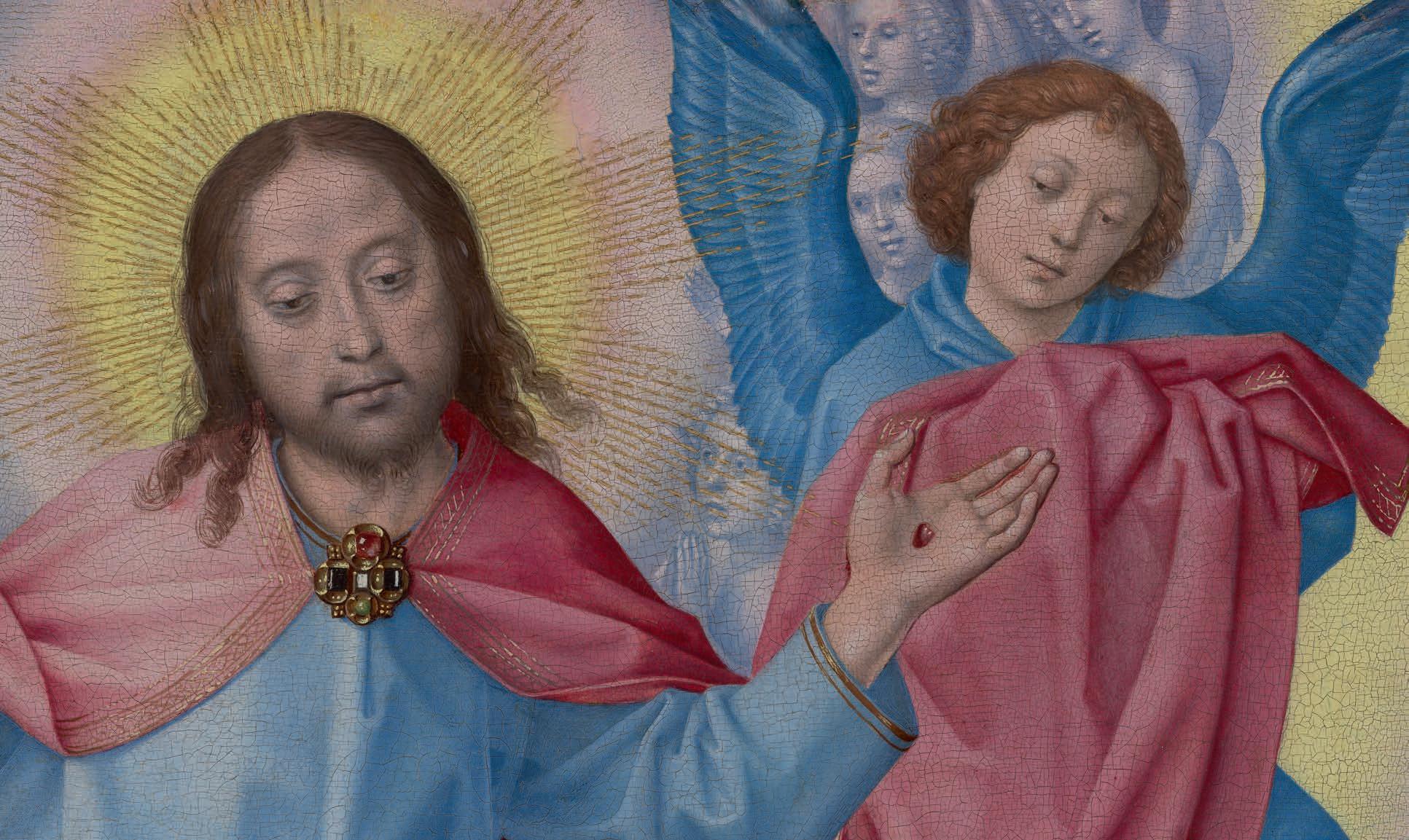
[brother Hugo] … was so renowned as a painter
that on our side of the mountains there was no one his equal at that time, it was said.
Gaspar Ofhuys, c. 1510
The Story of a Masterpiece
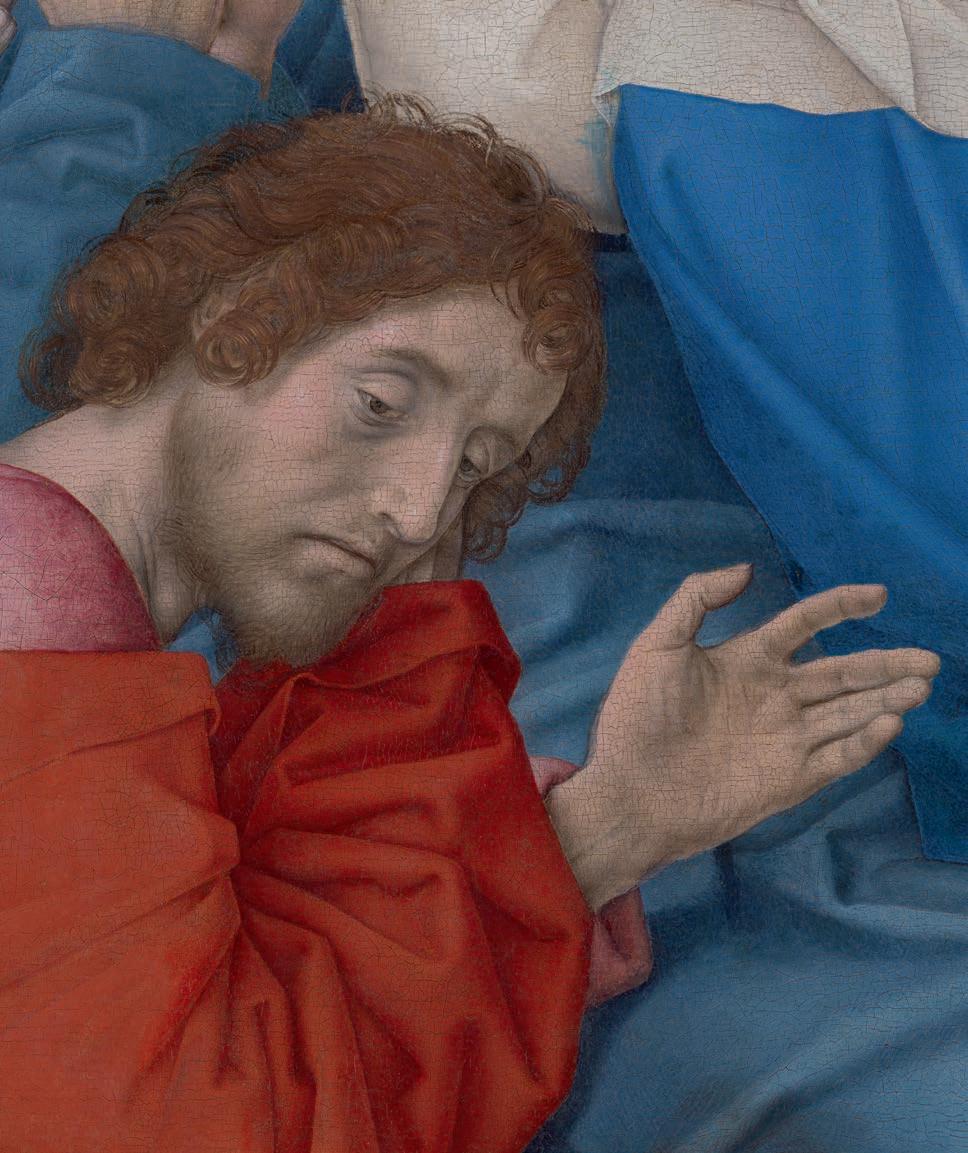 Matthias Depoorter
Matthias Depoorter
FIG. 1
Hugo van der Goes, The Death of the Virgin, 1475–82/83, oil on panel, 147.8 × 122.5 cm, Bruges, Musea Brugge, inv. 0000.GRO0204.I
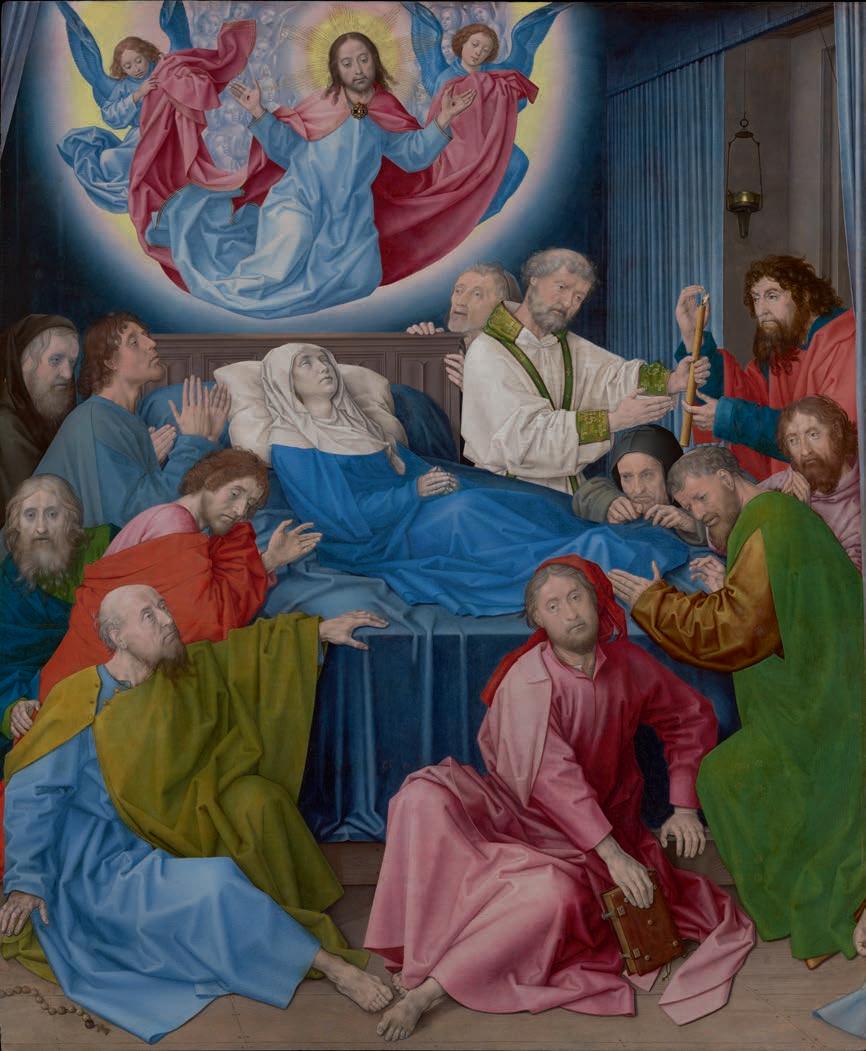
FIG. 2 (next page)
Hugo van der Goes, Portinari Triptych, c. 1477–78, oil on panel, 274 × 652 cm, Florence, Le Gallerie degli Uffizi, inv. 1890/3191-3193
Mary has fallen asleep. A deathly silence fills the cramped room. The apostles gather as closely as possible around Mary’s bed to form a closed circle around her body. They mourn for someone who was very dear to them and they each do so in their own way, just as everyone deals with grief and loss in their own way. They are intensely sad, but it is mostly an inner sadness. For some, a sense of disbelief predominates. They have not yet reconciled themselves to the irreversible. Others cry in their deepest self or are resigned. Some feel defeated. One of them grimaces, while another, who looks at us, seems to be in a daze. Two apostles are carrying out their duty: they have lit a candle as part of the ritual of coping with grief and to commend Mary’s soul to God. They all grieve the death of the Mother of God. They must continue in this earthly existence without their beloved. But there is hope. The apostles probably do not see how Christ has descended. He will receive his mother’s soul, after which she will be taken up into Heaven.
Introduction
The Death of the Virgin (fig. 1) is an exceptional painting from the equally exceptional oeuvre of Hugo van der Goes (c. 1440–1482/1483). Although only a handful of his works have been preserved, this is enough to consider him one of the most influential and talented artists of the fifteenth century. Of the painters of the Burgundian Netherlands he fits seamlessly into the gallery of the greats – coming after both the first generation of Jan van Eyck (c. 1390–1441), Robert Campin (c. 1375?–1444) and Rogier van der Weyden (c. 1399–1464), and the next with Petrus Christus (1415/1420–1475/1476) and Dieric Bouts (c. 1410/1420–1475), coinciding with the last grouping, to which Hans Memling (c. 1435–1494) and Gerard David (c. 1455–1523) belong. These are the so-called Flemish Primitives or painters who were active in the Burgundian Netherlands (present-day Belgium and parts of northern France, the Netherlands and Luxembourg) in important political, mercantile and religious centres such as Bruges, Tournai, Ghent, Brussels, Mechelen, Leuven and, somewhat later, Antwerp. They were anything but primitive in the contemporary sense of the word. They were trailblazers, they were precursors. In the fifteenth century, the influence of these artists on Western painting was particularly great and even fundamental. Of crucial importance is the fact
that it is in this region that the medium of oil paint was perfected. This brought about a revolution, and with it the development of superior skills in terms of painting techniques. Art from the Burgundian Netherlands was considered a mark of quality, and paintings by the Flemish Primitives were exported to all corners of Europe. Although a painterly revolution was under way in the same century in Italy – particularly in Florence with such famous names as Fra Angelico, Masaccio, Filippo Lippi, Andrea Mantegna, Sandro Botticelli and Leonardo da Vinci – it is significant that the paintings of the Flemish Primitives were much in demand among Italian art lovers, and that Italian painters drew inspiration from these works. The panels were notable for their new realism, with far-reaching detailing and luminous colours made possible by the use of oil paint.
The work of Hugo van der Goes was also well known in Italy. Today, the Portinari Triptych (fig. 2) is considered his most important and largest work. The Florentine Medici banker Tommaso Portinari (1428–1501) commissioned this triptych. Portinari was a flamboyant and fabulously rich man. His life story almost reads like a picaresque novel. In 1465 he became a branch shareholder and co-shareholder of the Medici Bank in Bruges and also a partner at the London branch. He housed the branch in Pieter Bladelin’s magnificent city palace on Naaldenstraat in Bruges. Medallions with the portraits of his superiors, Lorenzo
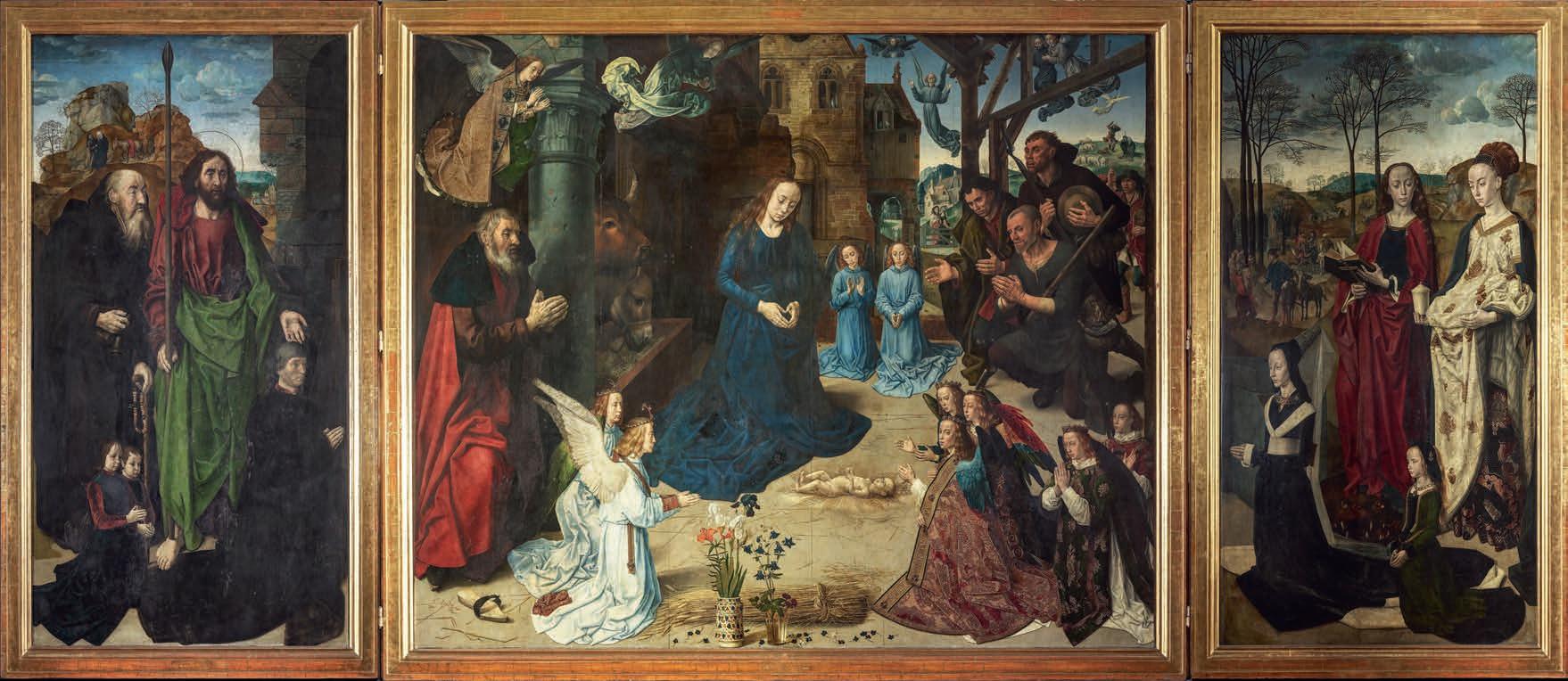
c. 1477–78, oil on panel, 274 × 652 cm, Florence, Le Gallerie degli Uffizi, inv. 1890/3191-3193
de’ Medici and his wife Clarice Orsini, still bear witness to those glorious days and to Bruges’s connection with Florence. Portinari did everything in his power to associate with the Burgundians. Bladelin had been councillor to Philip the Good (1396–1467) and Portinari did business with this Burgundian duke. He also acted as one of his councillors. He gave diplomatic advice to his son Charles the Bold (1433–1477) and lent him large sums of money to finance his wars. The repayment of these loans eventually proved impossible after the duke’s death in 1477 at the Battle of Nancy. These and other malpractices would herald the end of both the Bruges and London Medici Bank branches. Nevertheless, Portinari continued to be called on for diplomatic assignments by Emperor Maximilian of Austria (1459–1519) and his son Philip the Handsome (1478–1506). He also succeeded in settling the conflict with Lorenzo de’ Medici.
Tommaso Portinari had an eye for pioneering art. He ordered at least two works from Hans Memling, among which a Passion scene (Galleria Sabauda, Turin) with the kneeling portraits of himself and his wife Maria Baroncelli, as well as a devotional triptych whose side panels with both their portraits have been preserved to this day (The Metropolitan Museum of Art, New York). He and his wife and children are also depicted on Van der Goes’s Portinari Triptych (fig. 3). After The Adoration of the Mystic Lamb by the Van Eyck brothers (1432, St Bavo’s Cathedral, Ghent), the painting is one of the largest works of the Flemish Primitives to have been preserved. Hugo van der Goes put all his genius into it, but never lived to see the moment when the altarpiece was installed in Florence, the beating heart of the Italian Renaissance. He died before or during it was being shipped via Bruges to Pisa, from where the masterpiece was transported further via the Arno to Florence. Sixteen men then carried the panel to the Hospital of Santa Maria Nuova. There, in 1483, it was given a place on the main altar in the Chiesa di Sant’Egidio, the hospital church, in the Portinari family chapel.
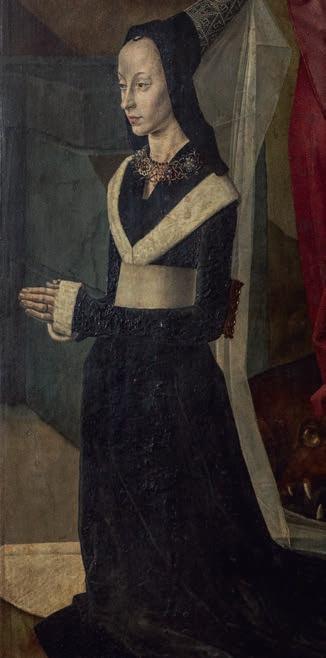
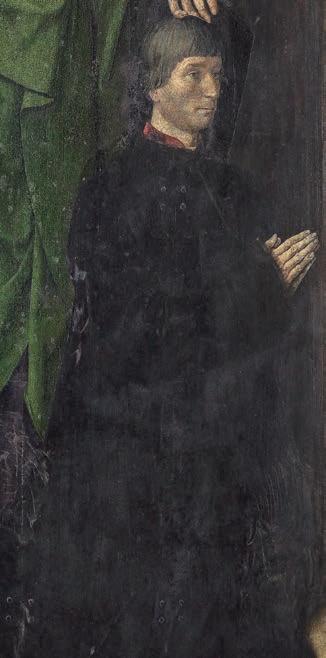
It must have made an unforgettable and exotic impression on the painters in the city. Domenico Ghirlandaio (1449–1494), who taught Michelangelo to paint (frescoes), fed upon the artistry of Van der Goes, as did his colleagues Sandro Botticelli (c. 1445–1510) and Filippino Lippi (c. 1457–1504).
That the Portinari Triptych was by Hugo van der Goes we owe to Giorgio Vasari (1511–1574) who mentioned it in 1550 in the first edition of Le vite, his book of artist biographies. Although he calls the painter Ugo d’Anversa – the connection between Van der Goes and Antwerp is unclear – his attribution became the building block of further art historical research into the painter. Van der Goes’s oeuvre, which consists of only a few unsigned and undated works, was compiled on the basis of the Portinari Triptych. This also applies to The Death of the Virgin, the (with good reason) most idiosyncratic painting by Van der Goes that has survived.
For a long time, this master painter remained largely unknown to the general public. In the nineteenth century, several (art) historians did some pioneering work reconstructing his oeuvre. But it was not until the Exposition des Primitifs flamands et d’Art ancien in 1902 in Bruges that everything gained in momentum. Viewed more broadly, this exhibition was a reference point for exhibitions devoted to artists from the Burgundian Netherlands. Since then, interest in Hugo van der Goes and The Death of the Virgin has only increased.
Art and context
Hugo van der Goes was active as a painter in the second half of the fifteenth century when the Burgundian Netherlands were the most urbanised region of Northern Europe. Trade and industry were flourishing, mainly due to the production of Flemish cloth which had been the driving force behind this economic prosperity since the eleventh century. The presence of capital fed the demand for art and luxury products, and metropolises such as Ghent and Bruges played an essential role in this. These very favourable socio-economic conditions formed the basis of a creative environment within an urban network in which highly skilled craftsmen and artists were enjoying their heyday. Hugo van der Goes was one of them.
Politically, this region was united by the dukes of Burgundy in the Burgundian Netherlands. In 1369, Margaret III, Countess of Flanders, married the Burgundian duke Philip II the Bold (1342–1404), son of the French king John the Good (1319–1364). In 1384 this marriage led to the union of French Burgundy and Flanders. Their grandson, Philip the Good, expanded
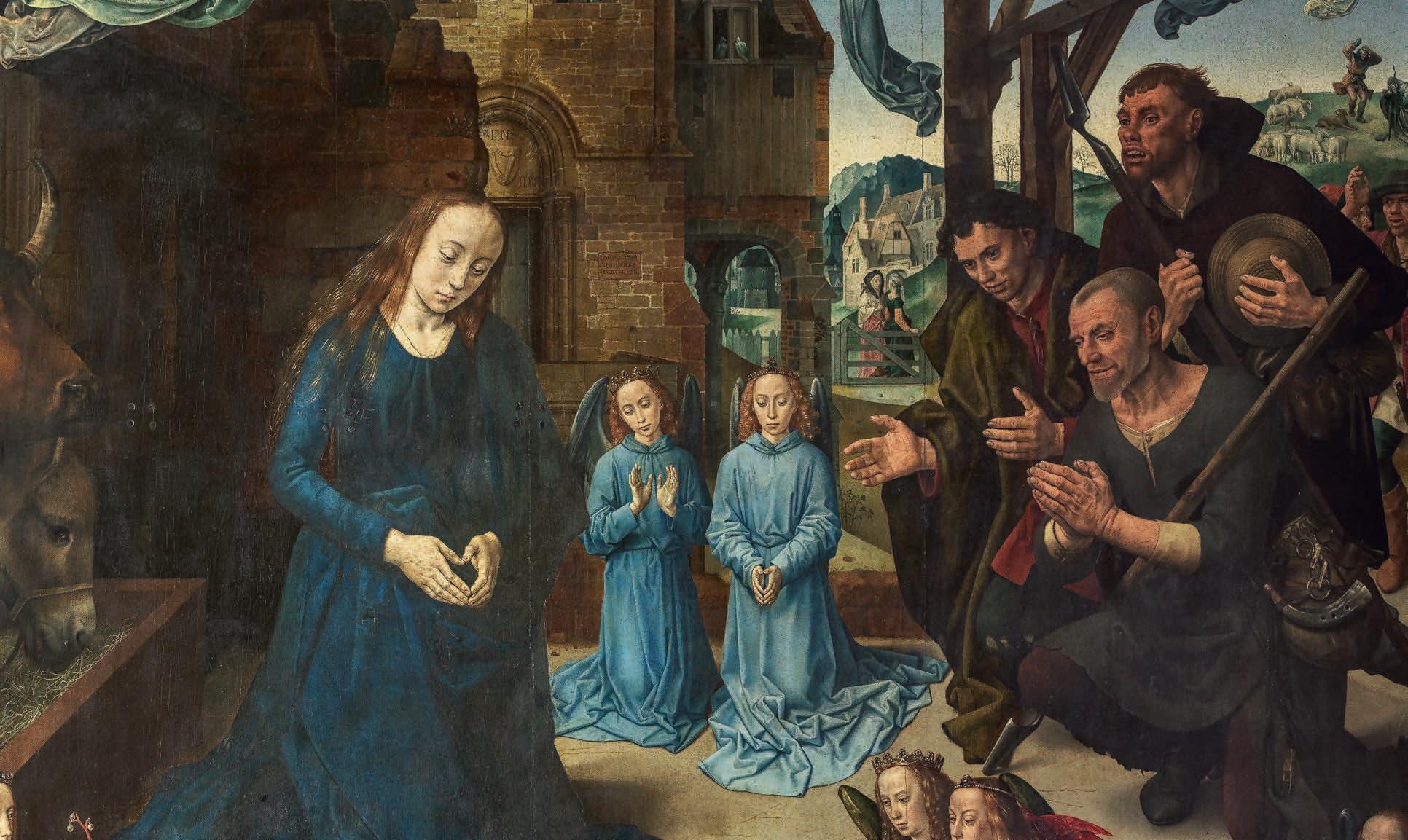
FIG. 20
Andrea Mantegna, The Dead Christ Supported by the Virgin Mary and St John the Evangelist, medio 1470 (?), tempera on canvas, 68 × 81 cm, Milan, Pinacoteca di Brera, inv. 352
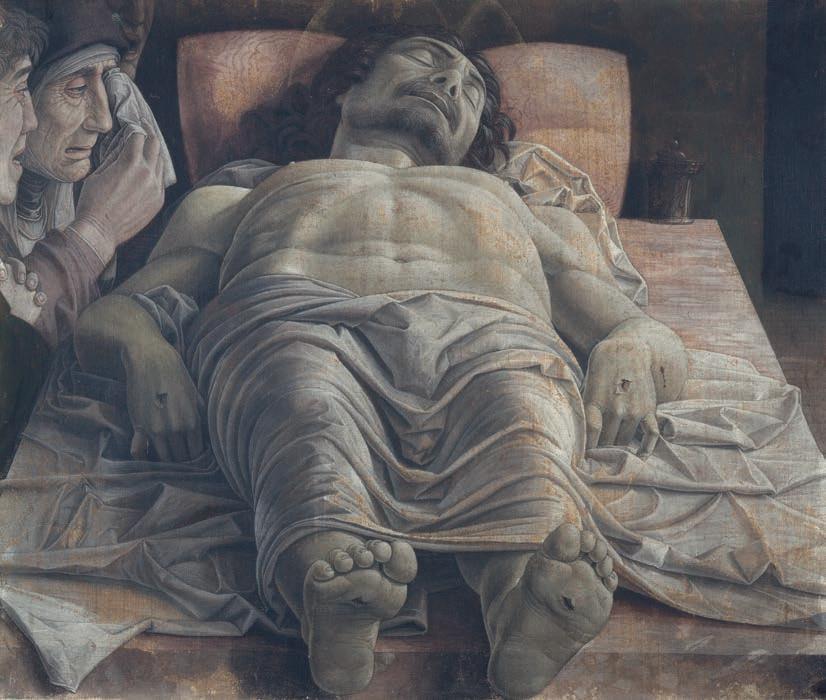
FIG. 21 (next page)
Hugo van der Goes, The Adoration of the Shepherds, c. 1480, oil on panel, 99.9 × 248.6 cm, Berlin, Staatliche Museen zu Berlin, Gemäldegalerie, inv. 1622A
vistas on the side panels put the focus on the painter’s ingenuity, as do the many details in the main scene. The painter Van Cleve is emphatically present, while Van der Goes tends to shy away.
Illusionism
Like the Christ Child in The Adoration of the Shepherds, Mary’s body is placed at an angle. Although Van der Goes depicted Mary’s body in a partially shortened manner, her oblique pose reduced the technical difficulty considerably. Otto Pächt compared this way of depicting with the contemporary The Dead Christ Supported by the Virgin Mary and St John the Evangelist by Andrea Mantegna (c. 1431–1506) (fig. 20). Mantegna’s technique is somewhat similar to Van der Goes’s, but then executed in a much bolder manner. In a shortened perspective, the artist placed the dead person spectacularly straight on the picture plane, as if we were right next to the body. Christ’s feet seem to be pressing against the picture plane. This kind of illusionism can be found in an early form in Jan van Eyck, particularly in Adam, who in the Mystic Lamb seems to step out of his niche. Van der Goes applied this formula rather sparingly in the surviving paintings. In the grisaille with St Genevieve, depicted on the outside of the Vienna Diptych, the cushion of the saint hangs over the edge of her fictitious niche. A tip of the Archangel Gabriel’s robe on the exterior panels of the Portinari Triptych is also just outside the niche. The two monumental figures at the front of The Adoration of the Shepherds (fig. 21) connect the viewers and the story in pictures and seem to enter the space of the viewer with their hands and arms.
Although the two apostles at the front in The Death of the Virgin do not possess this illusionism, they have the same function. Through their physical presence, they direct the viewer’s gaze toward the death scene. Interaction with the viewers is further enhanced by the two apostles who look at the spectator and thus make contact with the real, physical world. We see the same in the Monforte Altarpiece (fig. 22), in which the Child Jesus seeks contact with us. In the right-hand panel of the Vienna Diptych, it is the sobbing Mary Magdalene who makes contact with the viewer. The monumental figure on the right in The Adoration of the Shepherds looks penetratingly at the viewers and, because his mouth is open, he also seems to be speaking
to them. Similarly, the apostle on the left in The Death of the Virgin is looking at us and apparently wants to say something. Except for the bald head, the two figures are very similar, right down to the hypnotic gaze.
The effect of light and space
The effect of light is crucial in Van der Goes’s work, but he did not follow the strict and almost scientific lighting style of Jan van Eyck. Light sometimes plays a role of its own in his works and is thereby less tied to the reproduction of reality. Nevertheless, the depiction of light in The Death of the Virgin answers an internal, coherent principle. A source of light located on the left outside the scene illuminates the apostles. The divine bright light that accompanies Christ has a clear optical effect and enhances, for example, the marble-like appearance of Mary’s face, her veil and the pillow on which her head rests. The candle also sheds its light on the face of the apostle who holds her, and a light reflection can be seen in the suspended lamp in the adjoining room. This light incidence creates a chiaroscuro that translates into the tight fold of the robes of Christ, the angels and the apostles, and into the robe of Mary and the sheet on the bed. Taken together, this leads to a sculptural, almost plastic effect. The same holds for the faces and hands of all the characters.
Van der Goes sought out the limits of this light-dark effect in the angel hovering in the top left corner of the central panel of the Portinari Triptych. This section of the triptych is dark and more difficult for the viewer to read. This is partly due to the state of conservation, but possibly also to the painter’s artistic choice. Such an obscure part creates suspense and is reminiscent of the narrow space on the right in The Death of the Virgin. The painter shows what he wants to show and keeps us guessing about the rest. It is a view that has points of contact with Rogier van der Weyden’s The Descent from the Cross (c. 1435, Museo Nacional del Prado, Madrid), in which spatial orientation was reduced to a minimum.
Architectural elements or decorative solutions to structure the space recur in all paintings except the Vienna Diptych. Particularly in the Monforte Altarpiece, the Portinari Triptych, the Bonkil panels and The Adoration of the Shepherds, Van der Goes did not opt for a purely frontal view of a space. This is also the case with The Death of the Virgin, only here it is an enclosed space.
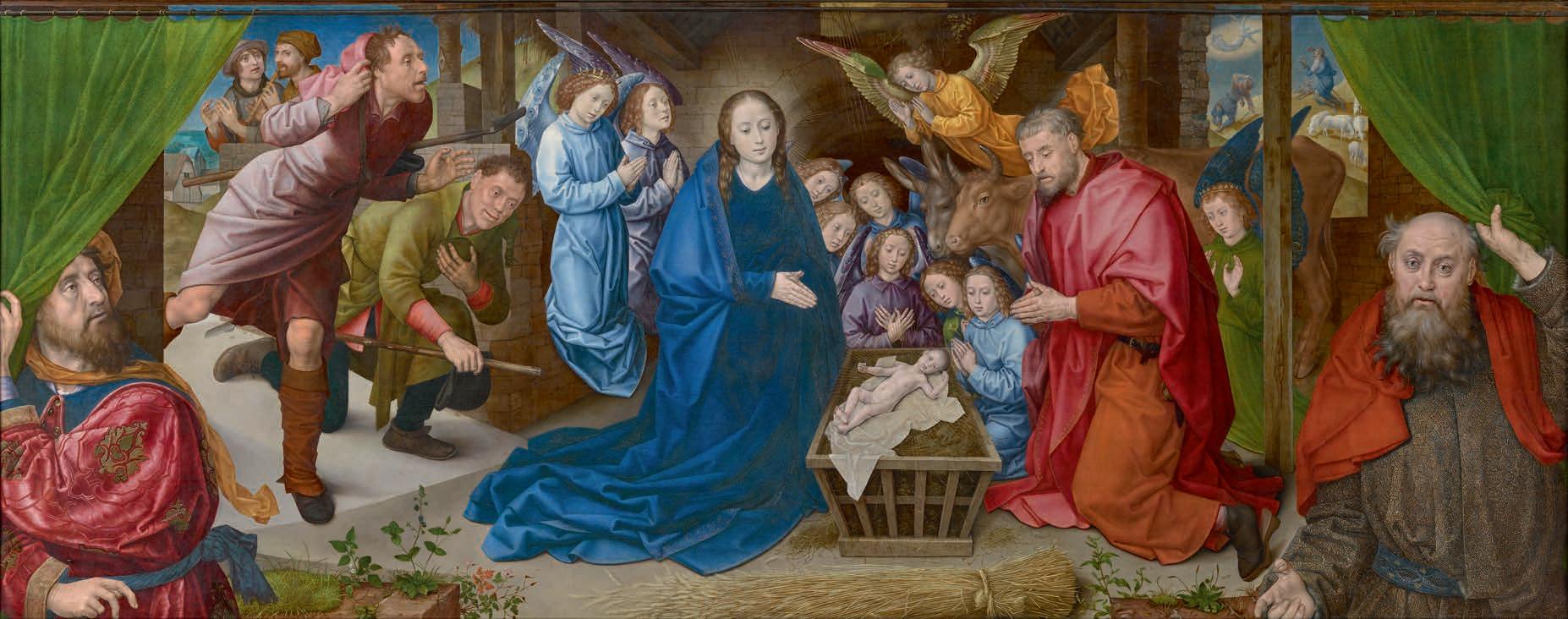
Meaningfulness and spirituality
The Modern Devotion:
Catholic faith at a turning point Van der Goes spent the last years of his life in the Red Cloister, which followed the Devotio Moderna or Modern Devotion movement. His late work has therefore been regularly linked to this religious movement because various scholars assume that this devotional attitude to life helped shape the artist’s spiritual ideas. Jan Crabbe, the abbot of Ten Duinen Abbey, favoured the Modern Devotion and is thought to have commissioned The Death of the Virgin. Since we can only guess at Hugo’s motive in becoming a lay brother and since he did not take his monastic vows, we must remain cautious in considering the Modern Devotion as an indisputable source of inspiration.
Nevertheless, there is no doubt that The Death of the Virgin emanates a spiritual power. The painting invites contemplation, inner reflection. The masterpiece undeniably has a deep religious meaning that can also be understood separately from the Modern Devotion.
The Modern Devotion movement emerged in the Late Middle Ages. The founder of this originally institutional movement of piety, a movement associated with religious orders and congregations of both men and women, was Geert Grote (1340–1384). The life principles of the movement’s followers did not just inspire the way of life of religious communities – the Modern Devotion evolved into a wider social movement, an historical phenomenon that steered the personal, devout life of both individual Christian citizens and religious community members. Both groups preferred a purer, more individual approach to the Catholic faith and wanted to return to the piety of the early Church.
For ordinary mortals, religious visual culture was a practical manual that represented devotional ideas. Images of the suffering Jesus and Mary found a following. Viewers could identify with them and found inspiration in the ordeals endured in their lives. Within the sphere of influence of the Modern Devotion movement, there was a great deal of vernacular literature describing the life and suffering of Jesus and Mary. In books of hours and prayer books, a balanced interaction was pursued between word and image. This enabled readers to project themselves fully into the story (fig. 10).
Prayer and meditation centred on the life and death of Christ, devotion to Mary, and the importance of the sacraments, were three important pillars on which this reform movement was based. The aim was to bring people to the essence of their faith, to direct contact and a union with God. Art and religion provided a guide to this end, but it is difficult to determine whether art commissions can be linked directly or exclusively to the ideas of the Modern Devotion. This renewed form of Christian faith helped pave the way for the Catholic reform that developed from the second half of the sixteenth century. Achieving spiritual purity through devotional contemplation and the reading of religious texts was important (fig. 11).
The Modern Devotion therefore played a major role in the dissemination of spiritual reading. The movement attached great importance to the use and production of means of communication that were new for that time, such as the printed book.
FIG. 10
Initial with Christ as Man of Sorrows, in Anonymous (Zwolle?), Sarijshandschrift met Getijden en Passieverhaal (Sarijs manuscript with Book of Hours and the Passion), c. 1465–85, parchment, 16 × 11 cm, Bruges, Public Library, Bruges, Ms. 673, f. 52r
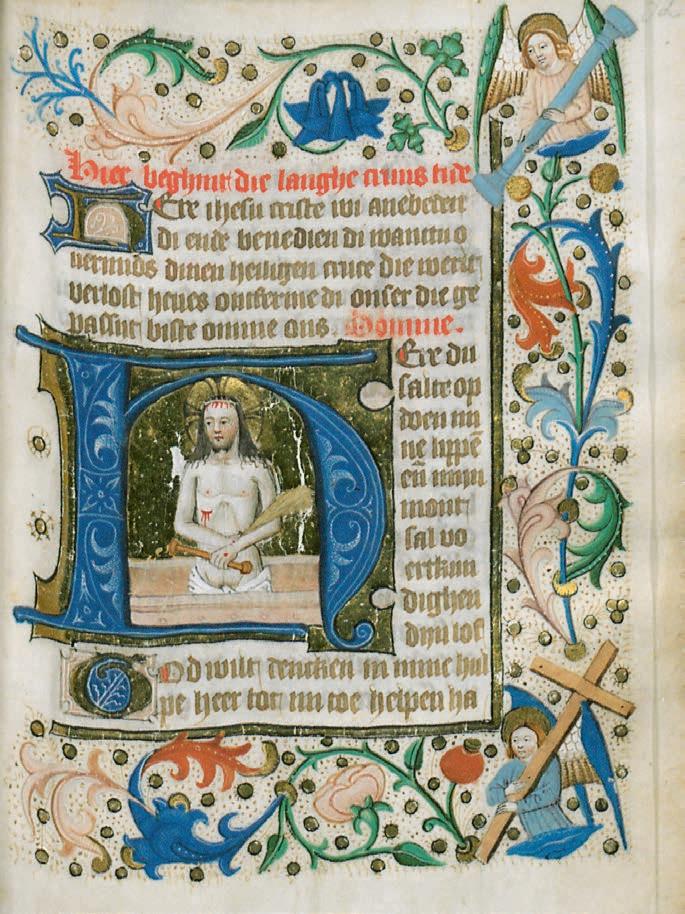
FIG. 11
Anonymous (Northern Netherlands), Die gheestelicke melody [The Spiritual Melody], 1460–80 (?), paper, 15 × 10.5 cm, Leiden, Leiden University Libraries, collection Maatschappij der Nederlandse Letterkunde, Special Collections Services, hs. LTK 2058, f. 39v
